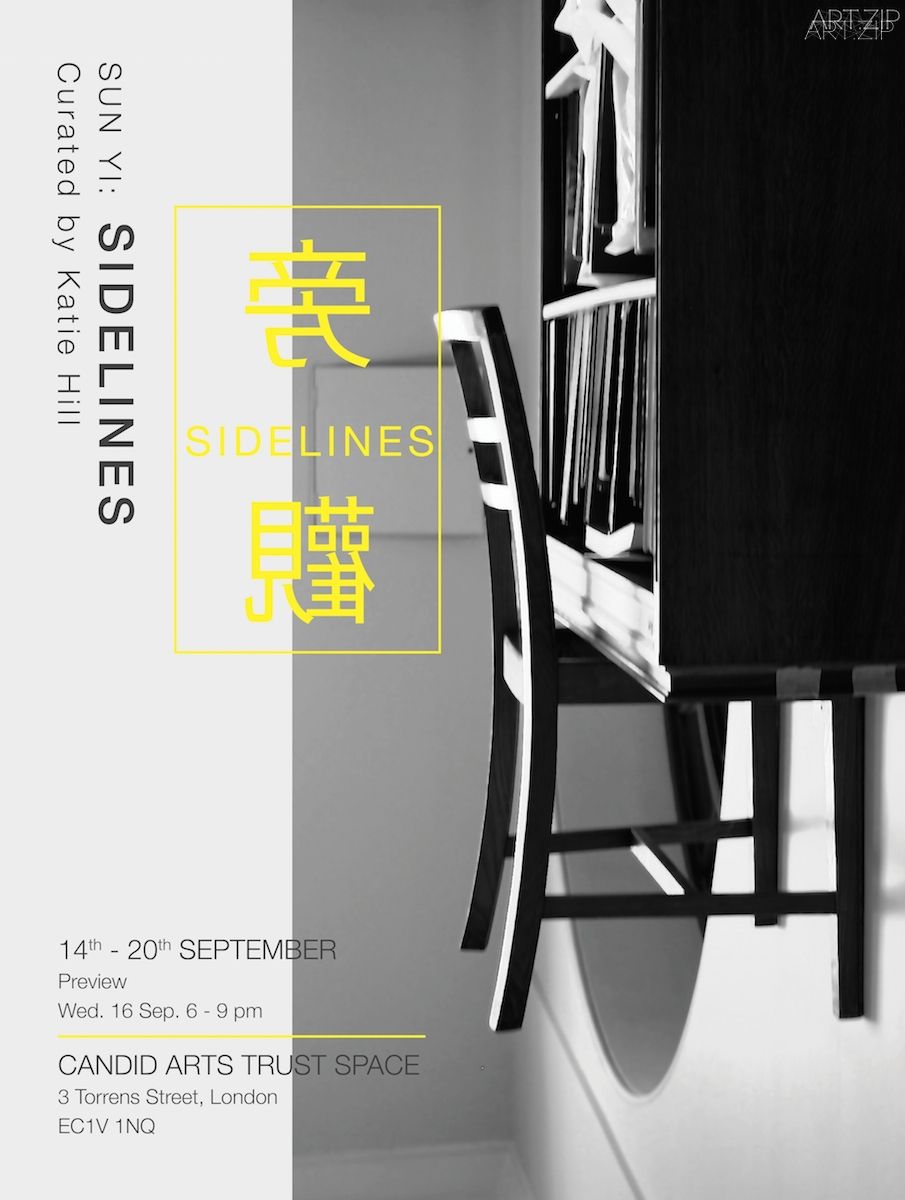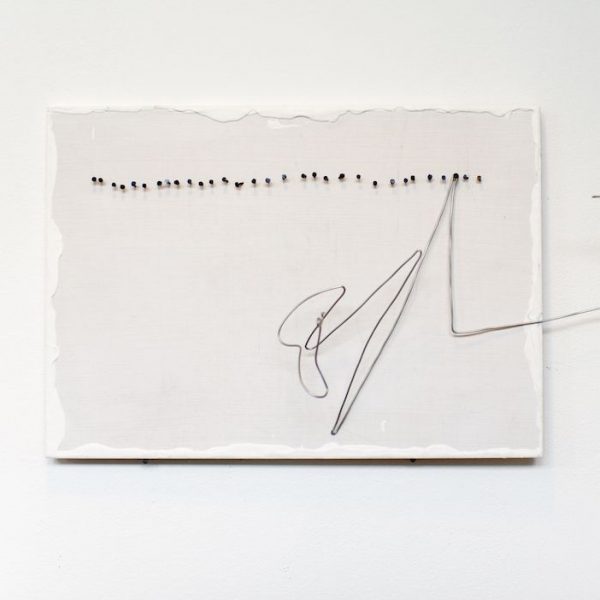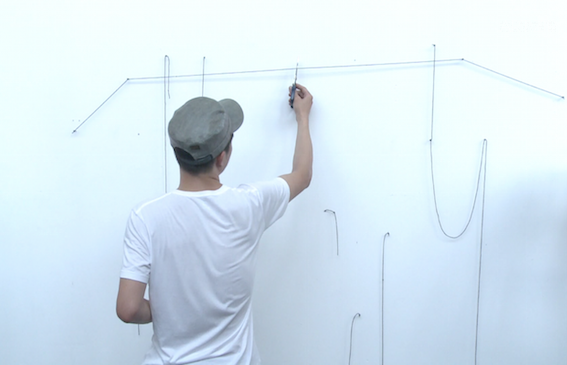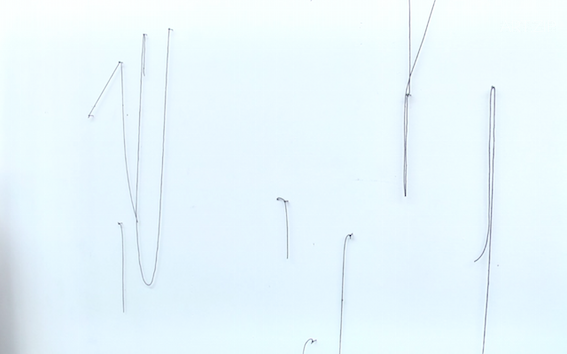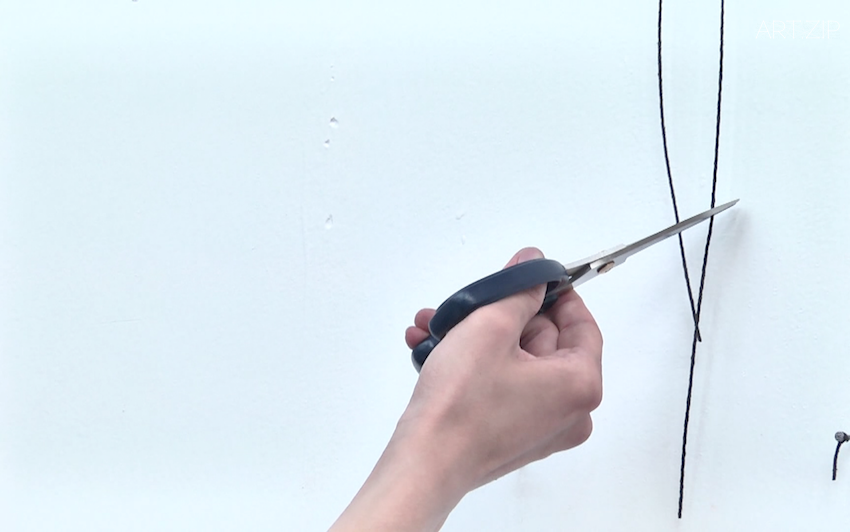
Exhibition dates: 14 – 20 September 2015
Candid Arts Trust Gallery
3-5 Torrens Street, London EC1V 1NQ
Private view: 16th September
Professionals’ reception: 17th September
.
.
ART.ZIP is pleased to announce Sidelines, a solo show by Chinese-born recent Slade graduate Sun Yi, presenting work from several series created throughout his degree, between 2013 and 2015.
The exhibition comprises 40 works across a broad spectrum of drawing, sculpture, installation and performance – bound conceptually in their origins in the everyday. A free newspaper left on the tube, a bench, a packet of cigarettes, debris, nails, wood, wire and string may be small and insignificant, forming the backdrop of life, but constitute the central component of Sun Yi’s work, running through both the materiality and form of his practice. A highlight of the exhibition is a vast 6x3m canvas, rusted into by the incorporation of recyclable objects and materials donated by major recycling corporation Tianjin Xinneng Renewable Resource Co.
A young artist from Tianjin, Sun Yi is an important coordinate in the collision between the West and China. Sidelines has been staged as a summary of his artistic creation during his academic career in Britain, and his unique study and pathway gives far-reaching sociological significance to the show – he is a dynamic model of the conflict between tradition and modernity, east and west, usefulness and uselessness, passage and eternity, forwardness and backwardness, lightness and weightiness.
Currently also exhibiting in Wastelands, a group show at OVADA, Oxford, alongside some of China’s best known contemporary artists such as Ai Weiwei and Cao Fei, Sun Yi is swiftly establishing himself as an artist of particular relevance in the international market. Wastelands, aligning eight contemporary artists with strong ties to China, explores the notion of ‘waste’ as a result of consumption through different landscapes and materials, engaging in themes of neo-liberal ideologies, consumption, development and economies of culture. These themes – along with other key concerns of the artist – are manifest furthermore in Sidelines.
Trained as a young apprentice in the traditional Chinese arts of drawing, ink and calligraphy, Sun was largely independent of the official educational establishment – with that its political burdens – and able to develop a comprehensive appreciation of Chinese classical philosophy and culture. It is because of this engagement with tradition that he is able to carry the core values of traditional Chinese culture, with all its proper precision and restraints. In balance, China was during that period insulated from the Western understanding of contemporary art. In choosing to study at Slade, therefore, an inevitable logical leap brought about conflict, integration, and an appreciation that his earlier isolation was, in fact, an enabling factor in his ability to directly and purely access the context of authentic contemporary art. Through study, continuous self-overturn and cultural collision, Sun Yi nurtured within himself a unique artistic clue—a passion to overthrow the supposed status and property of matters, to examine identity, to reflect on and practice contradiction itself.
Top: Found material drawing No.1 (2015), from the White Objective Drawing series; Bottom right and left: from the Cutting series
Drawing remains central to Sun Yi’s oeuvre, present even in the sculptural and object-based work. Lines, composition and material are manipulated, extending the act of drawing into three-dimensional space. Function is denied in favour of a philosophical and aesthetical positioning in sculptural form. With drawing at the emotion of his work, as a fundamental aspect of cultural expression connecting low and high art, Eastern and Western cultural traditions, works are whittled down and worked on, yet left barely discernible as aesthetic objects in their execution.
In his work can be found the constant search for a kind of ‘imperfection’ that is philosophically aligned with with Daoism or Chan Buddhism – humility and acceptance being valued above any outward display of ego, spectacle, capitalism or neo-liberalism. In his shift to London, such values fused with other philosophical thinking, forging a constant dialogue with the thinking of such philosophers as Kant, Wittgenstein and Agamben, demonstrating Sun Yi’s broad range of intellectual engagement in issues of taste, value and language. Referring to aesthetics, the western philosopher Kant holds that art should be detached from concept, disinterested from concern and divorced from purpose, so that it will attain the ideal “zweckmassigkeit ohne zweck” (purposiveness without purpose). Such ideas are echoed with the Chinese artistic philosophy which pursues a state of freedom both in the mind and the hand.
“Art, as far as I have practiced it, seems to me like water, tasteless, but you could never live without it. Whatever forms it takes, I get bored as the excitement fades and as time passes, I even forget it ever existed…In Chinese culture, ‘non-existence means existence’, ‘existence means Dao (the way)’ and ‘Dao’ can never be literally explained. In terms of this idea, I am relentlessly striving for the ‘non-existence’ of my work. Perhaps ‘being’ and ‘not being’ are of no difference, they are meaningless in the end, nothing but a different way of thinking. We are a generation that is experiencing the most revolutionary and competitive era of Chinese history. Everything is unbelievably fast and unsettling. The faster the country develops economically, the faster it degenerates spiritually. This might be one of the reasons that pushes me to ‘understatement’, or, even ‘non-existence’.” -Sun Yi
.
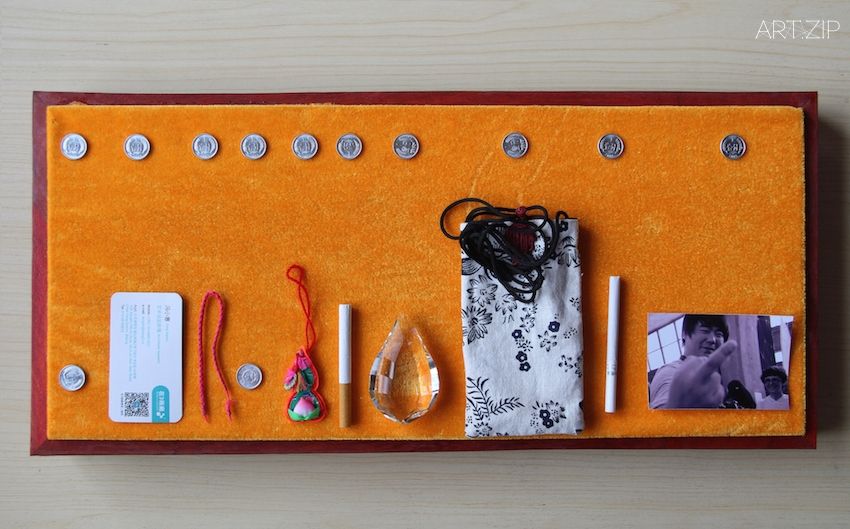

Above left: from the One Cent Project, 2014; Above right: December 8, 2014 (2014), newspaper, red acrylic, monoprint, 56x74cm
Sun Yi shattered the relationship between price and value of artwork through the One Cent project – the objects and the coin (also an object) become interchangeable in a value system that levels the field of values to a nominally flat plane. Here the art market is subtly invoked in a wry lowering of the stakes, as the question of materiality and culture is called in, in which artworks are shown up as exchanged in a distorted value system of cumulative capital and market forces.
Ultimately Sun’s works are an exploration of value as much as they are beholden to the aesthetic, cultural, social and economic – our very existence in a society is threaded together through value systems. Similarly, a news story may narrate the tragic, heroic or historic, but as an object, the story itself and the image, it is also dispensable, disposable, to be cast away until the next comes along. The artist reconstructs the connection between the timeliness and timelessness of news. By using throwaway newspapers, he satirizes the side effects of over-development, through the debris of ready-made products.
Equally ‘high art’ is set aside in Sun’s work, for small seemingly insignificant sketches that give back value through a small retrieval. The sketches, as meditational crossing and unravelling of connections, the daily act of calligraphy touches the surface lightly, allowing them to hover into view – to linger, reflect and reconnect. Sun’s is the opposite of spectacle or the often heightened language of contemporary art vocabulary in the mainstream art world. Perhaps in response to an earlier generation of forceful gestural work or giant-scale installations, he looks towards Twombly, On Kawara or Anastasi, whose works made different kinds of connections through drawing or marking time, as modes of touch, sensibility, sensory experience or acts of memory.
He works back into the underbelly, retrieving and considering what runs through society, manifesting itself in barely visible form, yet revealing disturbing ideologies and questionable modes of consumption. In a stratified economic value system, lowest common denominators are brought in such as pieces of wood, nails, string (dyed with ink), penny coins, scratching the base of our environment, showing a deep understanding of the ‘ordinary’ as essential and sustainable aspects of life. Sun calls drawing ‘an inexplicit and attractive object’ and perhaps this neat phrase describes his mode of practice.
Formally, Sun Yi’s work pursues a dialogue across different artistic vocabularies from China and the West, making connections with drawing, painting and sculpture as integral aspects of cultural production across time and space. The final works are accumulations of understandings of liminality, tension and the paradoxes that create the push and pull of forces and structures, in society and culture.
“‘Objective time’ and ‘spiritual space’ are impeccably pure, I regard the two as a perfect duo. Regardless of equality, we distinguish things as good and bad, beautiful and ugly, first and second, right and wrong, yin and yang, yes and no…
I love a connected world and a world of solitary independence.
I love sentimental tears, and indifferent streets.
I love seriousness, no less than craziness.
I love both the positive and the negative.
Existence as much as non-existence.” -Sun Yi, midnight, 23 June 2015
“He works back into the underbelly, retrieving and considering what runs through society, manifesting itself in barely visible form, yet revealing disturbing ideologies and questionable modes of consumption. In a stratified economic value system, lowest common denominators are brought in such as pieces of wood, nails, string (dyed with ink), penny coins, scratching the base of our environment, showing a deep understanding of the ‘ordinary’ as essential and sustainable aspects of life.”-Dr. Katie Hill, Exhibition Curator and Course Leader of the Asian Art & its Markets semester programme at Sotheby’s Institute
.
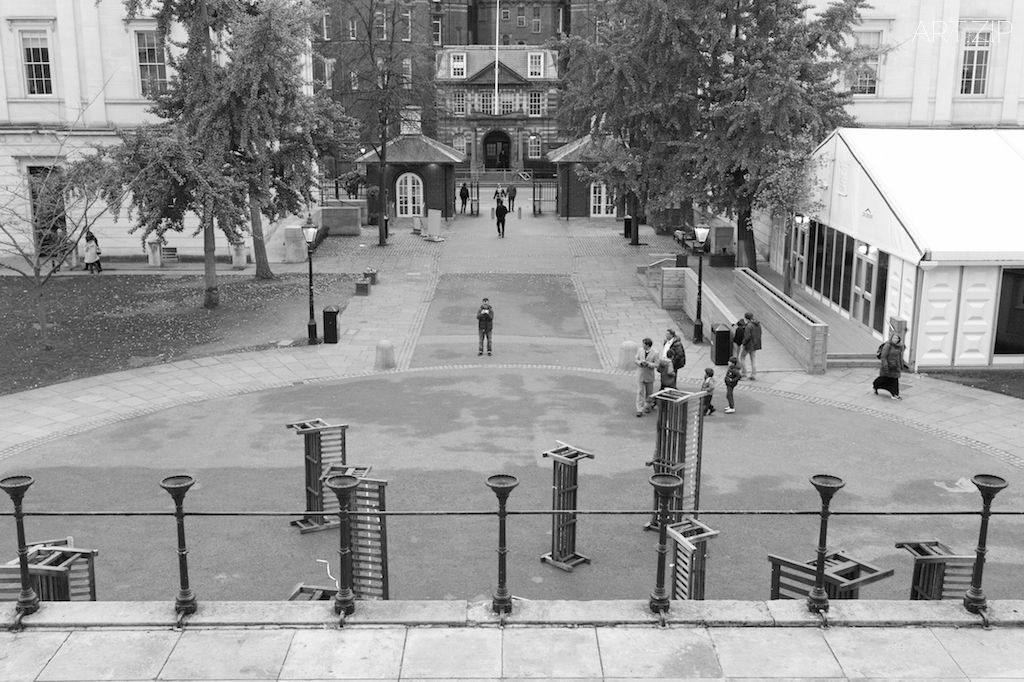
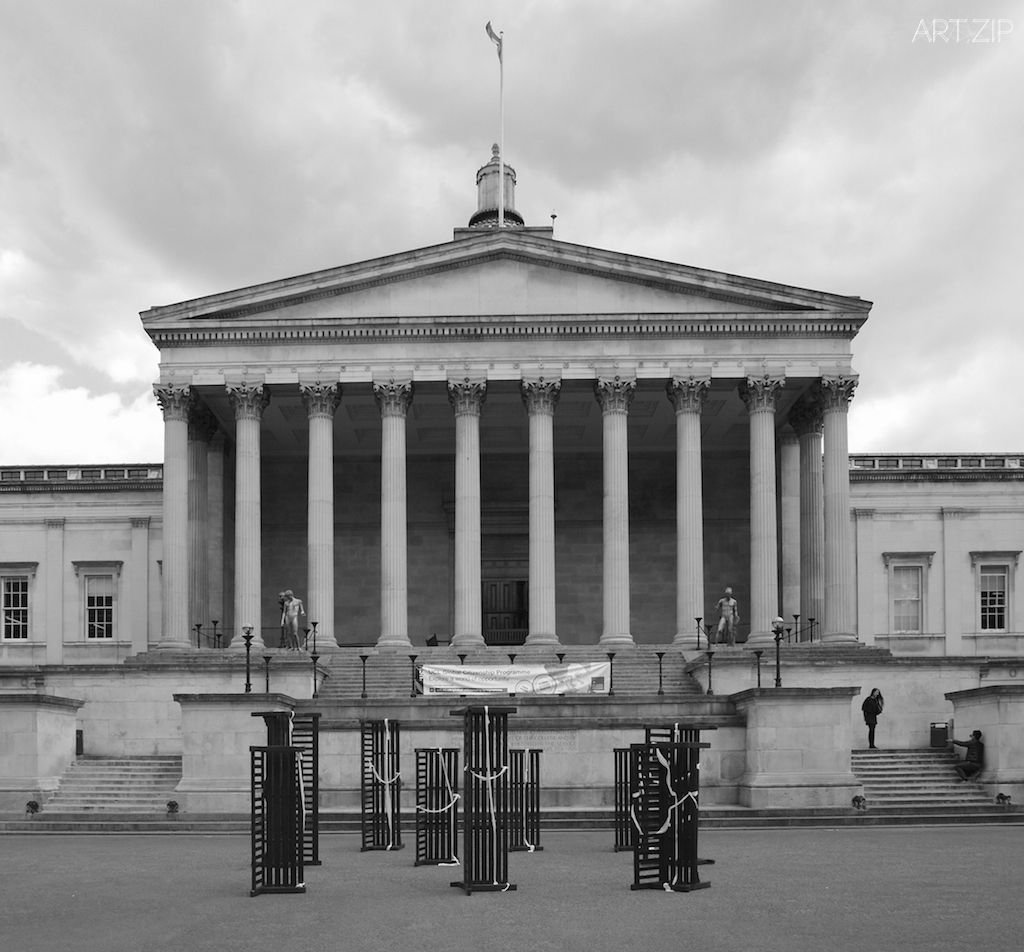
Performance Benches Holding Up (2014)
——————————————————————————————————————————————————————
孫毅個展──旁觀
展覽時間:2015年9月14-20日
卡迪德藝術畫廊( Candid Arts Trust Gallery)
3-5號 Torrens 街,倫敦,EC1V 1NQ
開幕酒會:9月16日18:00
ART.ZIP 誠邀您參加中國年輕藝術家孫毅個人作品展《旁觀(Sidelines)》,該展主要展示了2013至2015年孫毅在英國斯萊德藝術大學(Slade School of Fine Art ) 學習期間的作品。展出的40多件作品中包括了繪畫,雕塑,裝置以及行為藝術作品。隨手擲於地鐵上的免費報紙、板凳、煙、鐵釘或木屑、電線、繩子等等這些構成我們每天生活的不起眼的物品就是孫毅過去幾年藝術創作的核心素材,貫穿了他整個藝術創作的選材和形式。此次展覽的一大亮點是一幅巨大的6×3米的“繪畫”作品,孫毅利用廢品回收公司捐贈的材料,通過鏽跡滲透在畫布上而製成。
孫毅,一位來自中國天津的青年藝術家,一位畢業於倫敦斯萊德藝術學院(Slade School of Fine Art, University of London)的純藝碩士,一個中西文化碰撞節點上的座標。2015年9月,他在倫敦的第二次個人展覽《旁觀(Sidelines)》是其遊學英倫期間創作成果的總結性展覽,孫毅獨有的求學經歷和成長歷程使得這次的展覽具有了更為深遠的社會學意義──一個鮮活的傳統與當代、東方與西方、有用與無用、消逝與永恆、進與退、輕與重碰撞的樣本。
今年早些時候,孫毅的作品與中國著名當代藝術家艾未未、曹斐等人的作品一同參加了英國牛津的奧瓦達畫廊(OVADA)的群展《荒原(Wastelands)》,孫毅在國際藝術舞臺的知名度正在迅速建立。《荒原》由中國八位當代藝術家通過不同的風景和材料,以及新自由主義的意識形態,消費,發展和文化經濟的探討來探索了“廢棄”的概念。這些主題是其他藝術家所關心的,同時也是《旁觀》所要探索的。
孫毅自幼學習中國傳統繪畫和書法,孫毅的學習沒有中國官方教育體制帶來的政治負擔,從而讓他能發掘更多中國古典哲學和文化的價值。因為這些對中國傳統文化的了解, 他承擔了更多中國傳統文化的核心價值。中國傳統文化發展的時期完全隔絕了西方藝術文化的影響。孫毅選擇在斯萊德學習,必然會帶來衝突和融合,以及對他早期中國傳統藝術學習隔離時期的讚賞。事實上,這也給了他更多的有利條件去直接和純粹地去探討真正的當代藝術狀況。通過不斷地自我顛覆和文化碰撞,孫毅探索出了獨特的藝術線索————推翻問題固有的狀態和屬性,探索本質,反思實踐和矛盾的本身。
“繪畫”這樣的創作方式在孫毅的作品中也佔有中心的地位。利用線,材料將繪畫行為延伸到三維空間中。在雕塑作品中,因為哲學和美學的定位,作品本身的功能性被省略。隨著情感在孫毅繪畫作品的突出,文化表達的功能方面連接了低俗和高級藝術,東方和西方文化傳統,停止和進行中的作品。他的作品含蓄克制,幾乎就像是一段粗糙的木頭,雖然加工過,但從技法和外觀上幾乎看不出來是被賦予了審美觀念的藝術品。
孫毅在作品中孜孜不倦地尋找“不完美”這種與道家和佛教禪宗哲學相吻合的特質,更注重謙遜和逆來順受,而不是追求自我的外在展示或誇張的表演,然而後者恰好是當下後全球資本主義和新自由主義的價值觀。對於現身處倫敦的孫毅來說,這樣的價值觀已和其他哲學思想相融合。在談話中,孫毅經常提及康德、維特根斯坦、阿甘本等哲學家,這體現出他對品味、價值和語言等智識領域有著廣泛的涉獵。關於美學,西方哲學家認為藝術應該從概念中分開,從關心和目的中分開,使之達到理想的“目的性無目的”。恰好這些概念和中國藝術哲學追求的自由狀態也是相符的。
“到目前為止,做藝術的經驗告訴我————這如同每日喝水一樣,沒什麼味道,但是又缺少不得。不論做了什麼作品,有了什麼樣的草稿,平淡下來後興奮也就沒了,時間久了可能也就忘了。……中國文化的精髓,其中一個便是‘無’,‘無’即是‘有’,‘有’便是‘道’,‘道’是不可說。所以,觀念上來說,我在努力讓我的工作和作品成為‘無‘。因為總覺得可能做與不做都沒有什麼實際的意義,個人的抒懷而已。我們這一代人正是在中國歷史上變革最大,競爭最激烈的時代生活和成長的。一切都迅速,不穩定,發展的膨脹和精神的衰退成了正比。可能也是這方面的原因,我才更嚮往平實,或者,走向更加極端,甚至這可能都是對虛無的傾向。”──孫毅
所謂的《1分錢計劃》是一組物件或者繪畫作品,旨在鼓勵交換。物件和硬幣(也是作為物件)可以進行互換,在這樣的價值體系裏,價值被校準到同一水平。由於物質性和文化問題的引入,藝術市場以不正常的低價向買家卑躬屈膝—————藝術品在累積的資金和市場力量所致的扭曲價值系統中以交易的形式出現。
歸根結底,孫毅的作品是對價值的探索,也是對布迪厄意義上的美學、文化、社會、經濟“習性”以及由價值系統交織的社會中我們存在的探索;一個描述生命隕落的新聞事件經常廉價地裝扮得聳人聽聞,然而報導本身、連帶著圖像都是可有可無、一次性的,新的一到舊的就可以置之腦後了。
同樣地,“高雅藝術”在孫毅的作品中還是留有地位的,因為那些看起來無足重輕的小速寫實際上通過小小的交易重獲了價值。這些速寫,作為日常書法冥想的交織和意義聯繫的澄明, 輕輕地跳躍於作品表面,盤旋著進入我們的眼界————流連著、反思著、重構著。孫毅是當今主流藝術世界宏大高調話語體系的反面。也許是為了回應力度氣度非凡的前代身體作品(Gestural Work)和巨型裝置藝術,他看齊的對像是托姆布雷(Twombly)、河原溫(Kawara)或阿納斯塔西(Anastasi),這些藝術家的作品通過繪畫或標記時間造成了各種聯繫,作為觸覺模式、感性、感官經驗或記憶行為。
他的創作有感而發,接收並考慮著社會上發生的事情,他的作品幾乎不可見,但卻揭示著令人不安的意識形態和可質疑的消費模式。在層壘分明的經濟價值體系裏,他引入了最小公分母,如木片、鐵釘、繩索(墨水上過色的)、硬幣,這觸及到了我們生活的基礎,展示了對這些作為生活中重要的可持續一面的“尋常之物”的深刻理解。孫毅把繪畫稱為“模糊卻又吸引人的對象”,或許這個簡潔的詞匯也精確地描述了他藝術創作的模式。
從形式上看,孫毅的作品追求中國與西方藝術的交流對話,使得繪畫,雕塑形成了跨越時間和空間組成方面的連接。最後的作品是社會上對局限、緊張、駁論的積累理解。
Edited & Translated by Qiwen Ke
編輯 x 翻譯:柯淇雯

